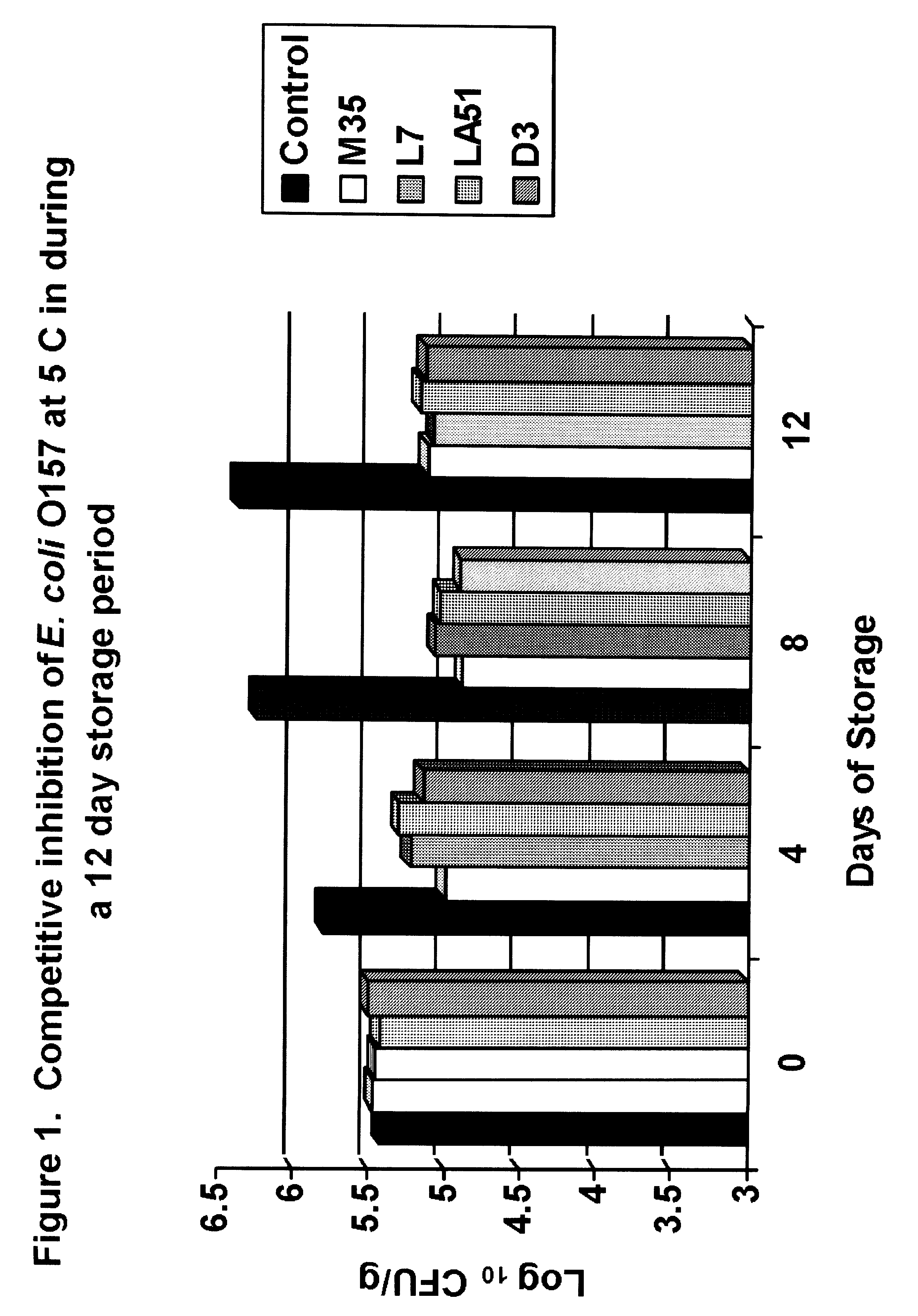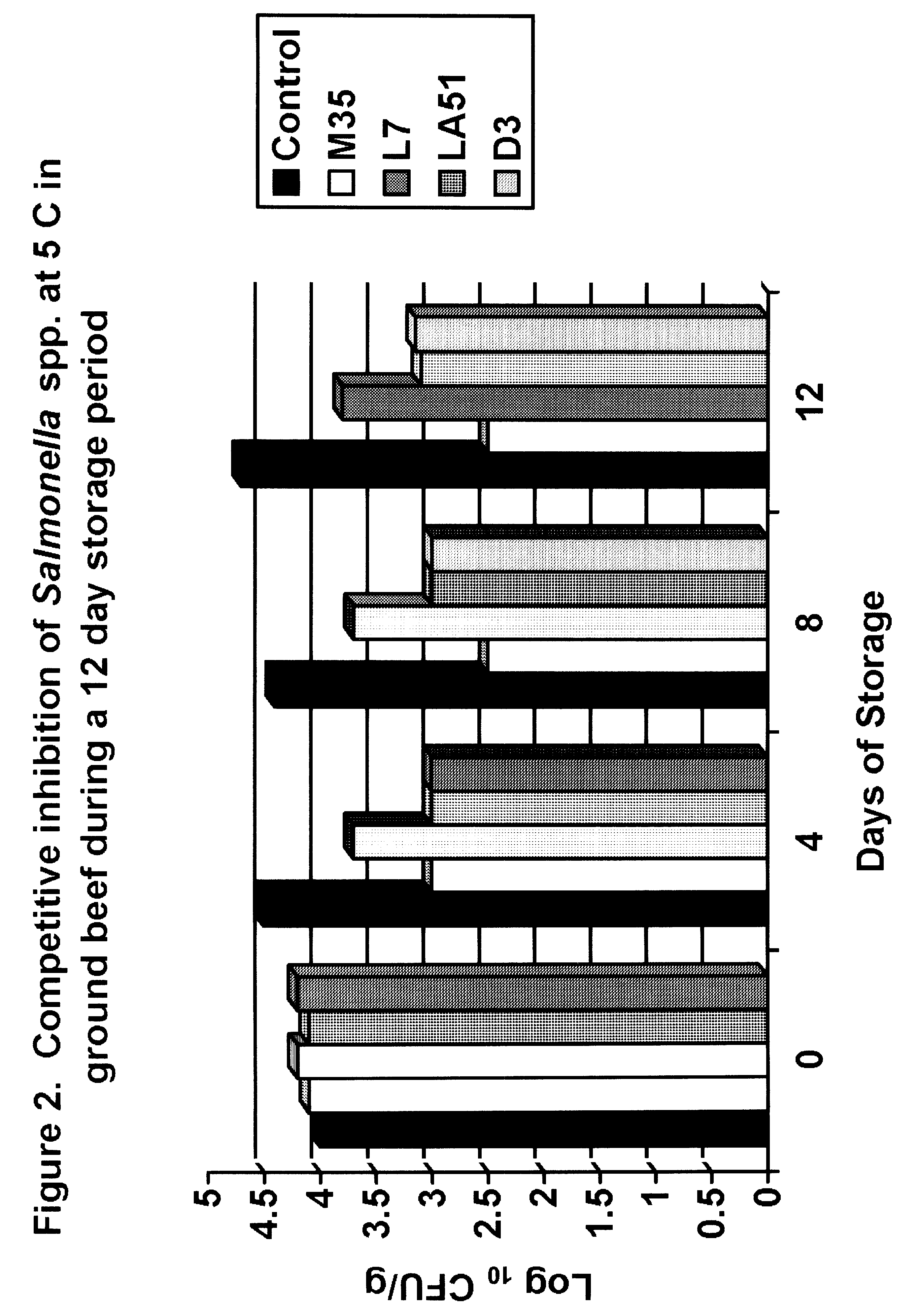Compositions and methods for reducing the pathogen content of meat and meat products
a technology of pathogen content and composition, applied in the field of reducing or eliminating the amount of pathogens in meat and meat products, can solve the problems of significant health concerns, insufficient cooking of food products, damage to the intestinal lining, etc., and achieve the effect of reducing or eliminating illnesses
- Summary
- Abstract
- Description
- Claims
- Application Information
AI Technical Summary
Benefits of technology
Problems solved by technology
Method used
Image
Examples
example 1
Culture Assay Results
[0032]A study was performed to evaluate the reduction of E. coli O157:H7 in ground beef. Four strains of lactic acid producing microorganisms were tested individually, and in combination.
[0033]Assays were performed in laboratory media stored at 5° C. Results were corrected using untreated samples as controls. Frozen concentrated cultures of Lactobacillus spp. NPC 747 (LA51), NPC 750 (M35), D3, and L7, and a mixture of all four cultures were used. Nalidixic acid resistant E. coli O157:H7 was used as the model pathogen. An inocula of 107 Cfu / ml of Lactobacillus was added to TSB broth containing 104 cfu / ml E. coli O157:H7. When the mixture of four Lactobacillus cultures was used, each culture was added at one quarter concentration, to result in a combined concentration of 107 cfu / ml. Samples were stored at 5° C. for ten days, with numbers of E. coli determined at days 0, 5, and 10. After five days of storage, no significant reduction in pathogen levels were observe...
example 2
Ground Beef Assay Results Using Individual Cultures
[0034]Ground beef samples were stored at 5° C. for 12 days to determine the impact of Lactic Acid Bacteria (LAB) on the growth and inhibition of E. coli O157:H7. After four days of storage, one of the LAB cultures, M35 resulted in significantly lower populations of E. coli O157:H7 compared to the control samples (FIG. 1). After 8 days of storage, the other three LAB cultures resulted in significant differences between control samples and treated samples with more than a 1.5 log difference (>90% reduction) between the control samples and the treated samples.
[0035]A more inhibitory effect was observed against Salmonella spp. After four days of storage, M35, LA51 and D3 resulted in significant reductions of Salmonella compared to the control samples (FIG. 2). Each of these resulted in a 1.5 log reduction after 4 days of storage at refrigeration temperatures. After eight days of storage, M35 resulted in a 2.0 log difference (99% reducti...
example 3
Ground Beef Assay Results Using Combined Cultures
[0037]Further tests were performed to determine if four strains of lactic acid bacteria (LAB) inhibited E. coli O157:H7 in laboratory media and in ground beef at 5° C. Frozen concentrated cultures of four Lactobacillus spp, NPC 747, NPC 750, D3, and L7 and a cocktail mixture of four strains of nalidixic acid resistant E. coli O157:H7 were used in this study. Nalidixic acid resistant strains of E. coli O157:H7 were used to facilitate recovery on non-selective media in the presence of the background flora.
[0038]A 107 cfu / ml portion of individual isolates of the LAB were added to TSB broth containing 104 E. coli O157:H7 / ml. Samples were stored at 5° C. and the numbers of E. coli O157:H7 were determined on days 0, 5 and 10. After 5 days of storage, there were no significant reductions in the pathogen. However after 10 days of storage, all LAB reduced E. coli O157:H7 by an average of 3 log cycles (99.9% reduction).
[0039]A second study was ...
PUM
 Login to View More
Login to View More Abstract
Description
Claims
Application Information
 Login to View More
Login to View More - R&D
- Intellectual Property
- Life Sciences
- Materials
- Tech Scout
- Unparalleled Data Quality
- Higher Quality Content
- 60% Fewer Hallucinations
Browse by: Latest US Patents, China's latest patents, Technical Efficacy Thesaurus, Application Domain, Technology Topic, Popular Technical Reports.
© 2025 PatSnap. All rights reserved.Legal|Privacy policy|Modern Slavery Act Transparency Statement|Sitemap|About US| Contact US: help@patsnap.com


